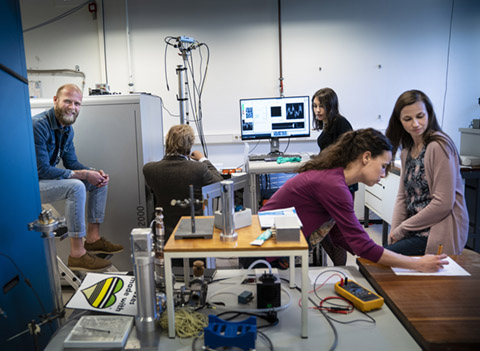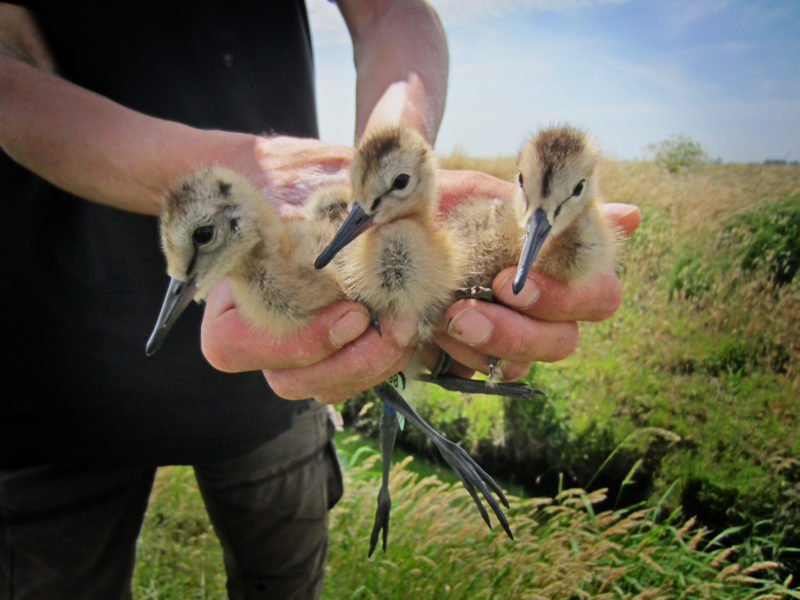
Alumni fund special projects
Small donations, big impact
The biggest donation to any Dutch university fund ever was to the UG.
A rich alumnus has donated at least 110 million euros to the Ubbo Emmius Fund (UEF) since 2016, and it looks like they’ll add another 36 million over the next few years. Their goal is to stimulate fundamental scientific research.
The university used the money to create CogniGron, a large-scale research project uniting physicists, mathematicians, computer scientists, and artificial intelligence experts. Together, they’re working on building a supercomputer with unparalleled processing power that’s also incredibly energy efficient. Scientists are calling it the computer of the future.
Ground-breaking
CogniGron is a great example of extremely experimental research. ‘It’s fundamental, ground-breaking research’, says Hans Biemans, portfolio manager with the UG’s board of directors.
‘We’re working on something that we’re not sure is going to succeed. But imagine if it, or some derivation of it, does end up a success. We might just come up with multiple solutions to various problems, such as energy consumption or the energy transition. I think that’s one of the greatest things we can, and in fact should do, at the UG.’
This donation is an exception
The prestigious, multi-disciplinary project has led to 69 academic publications since its inception in 2018. Approximately thirty professors are connected to the project, ten of whom were recruited from outside the UG, mainly from abroad. The first partnerships with organisations outside the UG have also started.
All that because a former student decided to make a large donation to the university.
Extra support
Are donations that important to the university? Not necessarily, says Biemans. ‘This donation is an exception. ‘If I’d have to guess, we receive approximately 4.5 million euros a year in donations. Our revenue is 800 million a year, so compared to that it isn’t very much, but it gives us the opportunity to do extra things that might not be possible otherwise.’
Remco Kouwenhoven, UEF director, puts the importance of the contributions into perspective. ‘Compared to the entire UG’s budget, it’s not that much. But on the other hand, it could mean the world to researchers who get that bit of extra support from it’, he says. Take, for example, this new project in which the UEF funds ten PhD candidates. ‘For them personally, it’s a huge difference.’
Money is often earmarked for a specific study
The UG isn’t entirely free to spend the money that is donated to the UEF and the smaller Groningen University Fund (GUF) as it wants, though. ‘Money that comes in is often earmarked for a specific study. The UEF essentially just passes it on’, says Kouwenhoven.
Ecology professor Han Olff once received a contribution from a foundation that wanted to support his work. ‘It’s enabled him to study wildlife in Africa.’
Kouwenhoven says people ‘regularly’ donate money to the UEF intended for Theunis Piersma. This summer, the professor of ornithology opened a new research centre in Leeuwarden, BirdEyes, which examines the world through the eyes of birds. The projects from this research centre are partially funded by the UEF. Anyone who’d like to contribute, can do so by hitting the donation button on the UEF website.
Affinity
Sometimes the university has more freedom to spend the money, such as when a foundation recently disbanded and donated more than a hundred thousand euros to the UEF to stimulate IT research and education. ‘It was up to us to find a suitable beneficiary. And no matter what we do, we always have to prove that the money was spent on what the donor intended’, says Kouwenhoven.
‘Donors want to feel like they’re really doing something for the university, like they’re returning the favour’, Biemans says. Many donors have a special affinity for certain subjects.
The donor really enjoyed keeping track of the project
He remembers one specific instance from when he was working at the fundraising department. A manufacturer and owner of a company that he’d got to know pretty well had always wondered what would have happened if he’d migrated to Canada after the Second World War, something he’d originally intended to do.
‘That was during a time when someone was studying Frisian people who had, in fact, migrated’, says Biemans. ‘The researchers asked people about their adjustment strategies. So this man financed a PhD track to figure this out. He’d come by twice a year to see how it was going and really enjoyed keeping track of the project.’

By the time the research was finished, the donor had had so much fun that he wanted to do something else with the university. ‘I asked him if he had any other questions he wanted answered. He said that he was religious and had a thing for churches. I happened to know that there was a professor who was about to retire who had a large collection of analogue photos of churches and church attributes from a specific time period. That collection needed to be digitised. The donor thought it was a great project to contribute some more money to.’
Ambition
According to Biemans, this example is typical of the Dutch way in which interested parties support the university. ‘They contribute to something they like, something they can hopefully enjoy, and it allows us to do something extra.’ The donations are often limited to a certain amount or a specific project. When the money runs out or the project is finished, it’s done.
While the UG does focus more on its alumni connections and fundraising these days, things in the Netherlands don’t work the way they do at universities in the United States, which have large fundraising departments that have targets to meet, and the tax system allows rich Americans to donate lots of money. ‘A lot of people say that they’re already contributing by paying taxes’, says Kouwenhoven.
According to him, the fundraising department doesn’t have any real ambition to grow. ‘We have no reason to think that fundraising will become much more important to the university’s core activities in the short term’, he says. ‘But I do have researchers knocking on my door several times a week because they could use some extra money. There is a need for research funds, and if we can get more funds, we can help more.’
Great relationships
In the end, fundraising isn’t the main goal of maintaining alumni relationships, says Biemans. ‘If they do give us money, that’s great, but ultimately our focus lies on maintaining a great relationship with the people who are and were involved with the university.’
Sure, he says, donations provide the UG with a degree of freedom to do projects that would have been difficult, if not impossible, to fund otherwise. ‘But ultimately, our roots lie in the North, formed by people and the relationships we have with them. That’s much more important to me.’